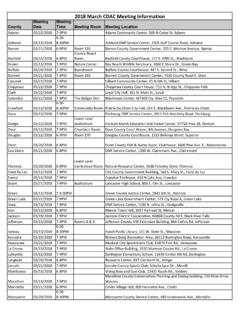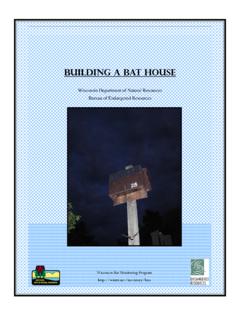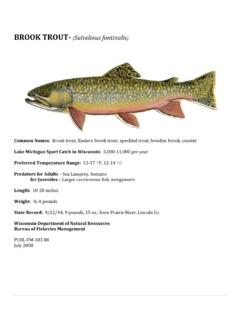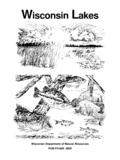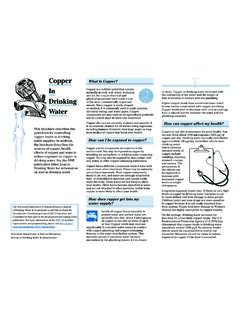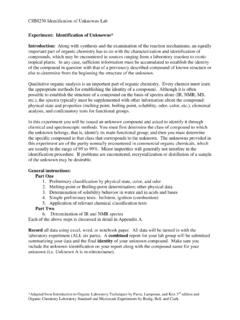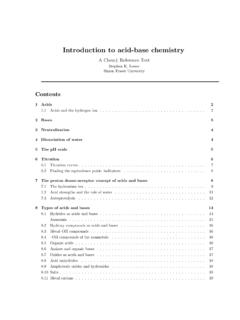Transcription of The Fundamentals of Chlorine Chemistry and Disinfection
1 1 The Fundamentals of Chlorine Chemistry and DisinfectionDecember 2007 George Bowman,The Wisconsin State Lab of HygieneandRick Mealy,The Wisconsin Dept. of Natural ResourcesHow do you respond to a water-related emergency?..it could be a bacterial reportedly becoming is it might be the it might be viral in natureHow do you respond?2 Nooooo! "The best defenseis a good offense." heavyweight champion Jack Dempseyis NOT an acceptable responseKill the bugsImaBugDisinfection (Chlorination)3 How does Chlorine kill? Chlorine kills cells by attacking the cell walls. Hypochlorous acid enters the cell wall with water and breaks down enzymes in the cell wall, leaving the bug open to not unlike a series of photon torpedoes knocking shields down leaving the ship vulnerableHow effective is Chlorine ?
2 We need a measure to gauge the killing power The measure commonly used is the CT value for any particular agent The lower the CT value, the more effective the killing agent is CT stands for Concentration x Time Concentration is in ppm (parts per million) Time is in minutes A CT value of 10 could mean Exposure to 10 ppm for minute (10 x 1 = 10) Exposure to ppm for 10 minutes ( 1 x 10 = 10) Exposure to ppm for 5 minutes ( 2 x 5 = 10)4 Reprinted from Journal American Water Works Association54, 1379, ,CT = }CT= 1CT= 2CT= 5CT= 10 Chlorine effectiveness at 0-5 C (3 log)CT values less than 1 for Chlorine against E. coli show high effectivenessEven a CT value of 400 means the resilient anthrax can be C0-5 C10 C10080604020100 51020 50100 Free Available Chlorine (FAC), ppmTime, minutespH= 7pH= effectiveness with temperature (composite view)CT increases5 Effect of Cl2on study on effect of Chlorine on E.
3 ColizTested 6 strains of O157:H7 at 4 mg/LX0 1 and2 minscontact timez5/6 isolates + E. coli control strain were highly susceptible to chlorinez>7 log10 reduction of each of these strains by mg/Lfree Chlorine within 1 min (CT value = )Each log10 = 90% reduction; 4 log 10= reductionSDWA requires 4 log reductionIn waters with pH between , the reaction is incomplete and both species (HOCl and OCl ) will be present. Hypochlorous acid (HOCl) is the more (20x) germicidal gas rapidly hydrolyzes to hypochlorous acid:Cl2+ H2O HOCl+ H++ Cl Aqueous solutions of sodium or calcium hypochlorite hydrolyze :Ca(OCl)2+ 2H2O Ca2++ 2 HOCl+ 2OH NaOCl + H2O Na++ HOCl+ OH The two chemical species formed by Chlorine in water, hypochlorous acid (HOCl) and hypochlorite ion (OCl ) are commonly referred to as free or available Hypochlorous acid is a weak acid and will disassociate:HOCl H++ OCl OK, Chlorine works, but how?
4 And why?6 HOClOCl-1009080706050403020100 Percentage of free Chlorine speciesFree Chlorine Distribution with pHCorrosivityconcerns below pH :50 equilibrium at pH Disinfection pH 6 - 7 .. of Chlorine /hypochlorite on addition to waterCl2+ H2O HOCl + H++ Cl Gas chlorineHypochloriteThe generation of free H+ions help to lower (OCl)2+ 2H2O 2 HOCl + Ca+ ++ 2OH NaOCl + H2O HOCl + Na++ OH HOCl H++ OCl HOCl H++ OCl HOCl H++ OCl Free OH-ions means pH is raisedNOTE: Sodium hydroxide (NaOH) is used as a stabilizing agent. On reaction with water, NaOH ionizes to Na+and OH-, thereby adding to the available OH-ions and further raising the Na++ OH NaOH Na++ OH Lower pH better Disinfection (HOCl is predominant)7 Effect of increasing bleach* concentration on pH of typical southwest WI pH % HOCl % from State Laboratory of Hygiene*Household bleach = available chlorineUse of household bleach: = pH, = OCl-, HOCl= effectiveness of gas is the best optionEffectiveness of Chlorine forms vs.
5 E. coliFrom: Reynolds & Richards, 1996. Unit Processes in Environmental Concentration mg/L Minutes, tc pH controlledInsufficient FAC2-6 C, 99% reductionHypochlorous acid >> Hypochlorite >> Chloramines8a) At pHs < 8, significant levels of HOCl are present-b) If NH3is present, HOCl will react to form one of 3 chloramines depending on pH, temperature, & reaction are chloramines? How do they affect Disinfection ? Chloramines: effective vs. bacteria but NOT viruses. c) additional free Chlorine + chloramine H+, H2O , and N2gas which will come out of : (stinky)2NH3+ 2 HOCl 2NH2Cl + 2H2 ODichloramine: (stinkier)2NH2Cl + 2 HOCl 2 NHCl2+ 2H2 OTrichloramine: (stinkiest!)NHCl2+ 3 HOCl NCl3+ 3H2 OChloramine Formation with Chlorine DosageSource: EPA 815-R-99-014, April 1999 Alternative Disinfectants and Oxidants Guidance Manual9 Chlorine Disinfection : other concerns Demands on chlorineInstantaneousIf the water contains iron (Fe+2) and manganese (Mn+2), insoluble oxides are formed on introduction of chlorineIntermediateReaction of Chlorine with ammonia to form combined Chlorine offers limited disinfectionLonger TermOrganic matter- Chlorine is consumed during the oxidation processDisinfection cannot proceed until the oxidant demand has been LINEFree Available Chlorine (FAC) is the major ( Disinfection agent)How do I know if I have free Chlorine (FAC) needed for best Disinfection ?
6 To have free available Chlorine for Disinfection you must be past the breakpoint Before the breakpoint, Chlorine is used up by inorganics (oxidizing Fe, Mn to chloride) and organics (chloramine formation) in the system Beyond breakpoint, every ppm of Chlorine added to the system is measured as FREE Chlorine Shock chlorination is another rapid way to ensure the presence of significant FAC. 10 Chlorine is reduced to chlorides by easily oxidizablestuff (H2S, Fe2+, etc.)Chloramines broken down & converted to nitrogen gas which leaves the system (Breakpoint).Cl2consumed by reaction with organic matter. If NH3is present, chloramineformation this point,THMformation can occurChlorination & an emergency, don t be concerned with THMs. SHOCK FIRSTask questions later Measure Free and Total Chlorine Bump up chlorinator to increase Chlorine dose a certain known amount On the following day, re-test Free and Total Chlorine .
7 If Total increases but Free does not, you are NOT at breakpoint. Repeat process until both Total and Free Chlorine increase similarly upon adjustmentEnsuring you are at Breakpoint11 Breakpoint FlowchartDay 1: Chlorine applied: mg/LFAC: mg/LTotal Residual: mg/LBump up the chlorinatorDay 2: Chlorine applied: mg/LFAC: mg/LTotal Residual: mg/LFree ppm; Total ppmBump up the chlorinatorDay 3: Chlorine applied: mg/LFAC: mg/LTotal Residual: mg/LDay 4: Chlorine applied: mg/LFAC: mg/LTotal Residual: mg/LFree ppm; Total no change Breakpoint!!!!!;;;Free ppm; Total ppmBump up the chlorinator+ ppm Cl2+ ppm Cl2+ ppm Cl2 Why Breakpoint Chlorination? Recommended deterrent to bioterrorism)2 of the DNR s 16 recommendations for reducing risk relate to chlorination)Many biotoxins can be inactivated by proper Disinfection with free Chlorine .
8 Public protection)Remember the Walkerton, Ontario outbreak (May 2000) of E. coli O157:H7 Liability protection for your water utility.) loss of life is a health concern at certain levels of exposure. Drinking water containing Chlorine in excess of standards: potential for irritating effects to eyes and nasal passages. potential for stomach you have too much Chlorine ? Disinfection ByProducts Rule(FR 12/16/98)Maximum Residual Disinfection Level(MRDL): mg/LCompliance is based on an annual or no risk with drinking water that meets the USEPA MRDL and should be considered safe with respect to Chlorine .(this allows the residual to be substantially increased on a short term basis such as would be required to deal with a known or suspected act of chemical/ bio-terrorism)pH & Disinfection ( Chlorine ):What you need to know1.
9 The best Disinfection occurs at lower If you have high alkalinity and high pH (> 8) consider longer Chlorine contact time due to reduced efficiency of the hypochlorite Chlorine (hypochlorite) is a strong base. Therefore, in a low alkalinity system, be wary of pH changes with Alternatives Chloramination UV Ozone Chlorine Dioxide BrominationChloramines as a disinfectant Addition of ammonia (NH3) and Chlorine (Cl2) compounds separately. Compounds typically used: Anhydrous ammonia Hypochlorous acid (HOCl) Ammonia is applied firstbecause it tends to prevent formation of trichloramine (chlorinousodor and taste) Adding ammonia first also prevents the formation of THMs. Target ratio: 3:1 HOCl to NH3produces the best tasting water14 Chloramines as a disinfectant Reactions Monochloramine: NH3+ Cl2= NH2Cl + HCl Dichloramine: NH3+ 2Cl2= NHCl2+ 2 HCl Trichloramine: NH3+ 3Cl2= NCl3+ 3 HClpH control is key to successful chloramination in PWS(Note for breakpoint chlorination):To eliminate NH3in drinking water using the breakpoint process, ( , surface water supply) Chlorine is fed at a ratio of 10-12 to 1 to the ammonia level.
10 When chloramines are used, the distribution system must be continually monitored for mono- and dichloramine residuals and DO. Total Chlorine is not FormationSource: EPA 815-R-99-014, April 1999 Alternative Disinfectants and Oxidants Guidance Manual15 Chloramination: potential problems Adding NH3may compromise water quality at the tap Should the residual chloramine be depleted in the distribution system, serious dead-end problems can result. Nitrification can occur. Residual chloramines can pass through RO membranes on dialysis machines which can cause damage to red blood cells. Chloramines are toxic to aquatic life in aquariums. Requires longer contact time to be an effective germicidal agent. The process is complex, requires careful control and continual monitoring.

